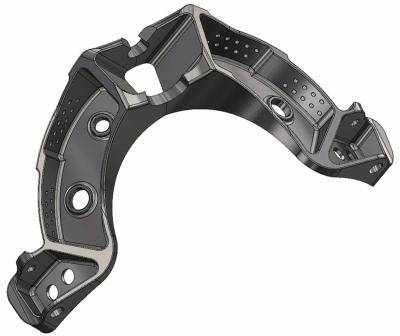
Multiaxis machining can dramatically increase a shop’s competitiveness. Mastercam Multiaxis is an add-on for Mastercam Mill 3D, Router 3D, Mill-Turn, and Mastercam for SOLIDWORKS®. It improves productivity with simultaneous 4- and 5-axis machining capability for Mastercam. Mastercam Multiaxis offers a wide range of multiaxis machining strategies, both basic and advanced. These toolpaths are also useful for advanced control of 3-axis machines.
The new Multiaxis Unified toolpath allows you to select multiple pieces of input geometry to generate the toolpath pattern. Using those geometry choices, the toolpath picks the best algorithm to calculate the path. This single toolpath gives you access to all the surface-based toolpaths, as well as the geodesic toolpath options, in a single interface.
New Deburr toolpath enhancements include a new option, Number of cuts along edges, which allows users to add multiple cuts to the Deburr toolpath, rounding or flattening edges, to create a quality edge on deburred parts. Additionally, the new Tilt Range options allow you to limit tilt when machining type is set to 5-axis (simultaneous) or 3+2 axis.
Maintaining climb and conventional machining is critical for surface finish and tool life. Controlling Climb and Conventional Cutting now provides control of climb or conventional cutting while working with surfaces that may require using both sides of a tool. It was previously impossible to maintain this while cutting a curved shape that would require the use of both sides of the tool.
Swarf Milling toolpath enhancements include the Drop tool to floor option which controls whether Mastercam will drop the toolpath down to a floor or retract to the bottom of swarf surfaces. The new Sorting Spiral Multi Cuts option allows multiple slices to be output as a spiral instead of single slices, providing a better finish across the part.
Rotary Advanced toolpath enhancements include the Axis offset option which allows you to shift the tool off-center to maintain a better contact point, which extends tool life and improves the machining quality. The new Smoothing options round sharp corners using a perfect of the stepover.
Mastercam continues to expand the critical machine simulation needed for optimal multiaxis programming with Mastercam Simulator which includes the new Smart Measure feature that allows you to measure distances quickly and accurately in the graphics window during simulation. Simulator now processes standard 3-axis and 5-axis operations faster when backplotting, verifying, or simulating, and now lists all collisions, proximity alerts, and axis overruns in the new Report pane.
Additional enhancements to Mastercam Multiaxis include:
- Maintaining a single tool axis orientation with Accelerated Finishing tools, providing optimal tool axis control to minimize or eliminate extra multiaxis movement.
- The new Point tool to rotary axis option allows you to rotate a toolpath around an offset point instead of the toolpath being fixed to the axis itself, which leads to a better tool contact point.
- The new Automatic arc lead-in type creates automatic arcs in locations where it can be difficult to determine the correct arc to fit and makes it easier to add arcs to linking moves.
- New Apply filtering for conversion generates a more efficient toolpath by filtering incoming toolpaths to reduce size and noise.
Contact Details
Related Glossary Terms
- gang cutting ( milling)
gang cutting ( milling)
Machining with several cutters mounted on a single arbor, generally for simultaneous cutting.
- milling
milling
Machining operation in which metal or other material is removed by applying power to a rotating cutter. In vertical milling, the cutting tool is mounted vertically on the spindle. In horizontal milling, the cutting tool is mounted horizontally, either directly on the spindle or on an arbor. Horizontal milling is further broken down into conventional milling, where the cutter rotates opposite the direction of feed, or “up” into the workpiece; and climb milling, where the cutter rotates in the direction of feed, or “down” into the workpiece. Milling operations include plane or surface milling, endmilling, facemilling, angle milling, form milling and profiling.
- milling machine ( mill)
milling machine ( mill)
Runs endmills and arbor-mounted milling cutters. Features include a head with a spindle that drives the cutters; a column, knee and table that provide motion in the three Cartesian axes; and a base that supports the components and houses the cutting-fluid pump and reservoir. The work is mounted on the table and fed into the rotating cutter or endmill to accomplish the milling steps; vertical milling machines also feed endmills into the work by means of a spindle-mounted quill. Models range from small manual machines to big bed-type and duplex mills. All take one of three basic forms: vertical, horizontal or convertible horizontal/vertical. Vertical machines may be knee-type (the table is mounted on a knee that can be elevated) or bed-type (the table is securely supported and only moves horizontally). In general, horizontal machines are bigger and more powerful, while vertical machines are lighter but more versatile and easier to set up and operate.
- swarf
swarf
Metal fines and grinding wheel particles generated during grinding.
- toolpath( cutter path)
toolpath( cutter path)
2-D or 3-D path generated by program code or a CAM system and followed by tool when machining a part.
